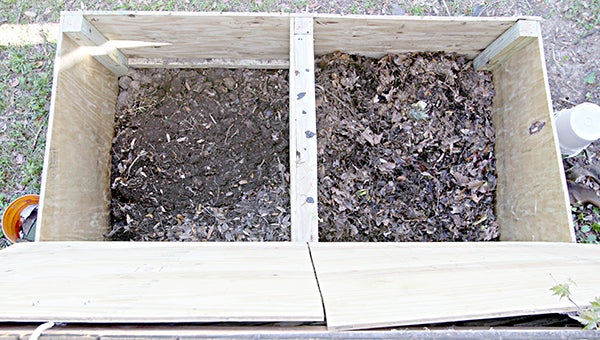Composting 101: Lunch and Learn offers tips, tricks
Published 12:08 am Saturday, April 9, 2016

- NATURE AT WORK: Martin’s at Midtown keeps two composting bins where compost is made from kitchen scraps and other green material.
Lawn clippings, leaves, branches and the like make up 30 percent of material at landfills, and when food materials and paper products are added, the percentage is even greater, 67 percent, according to the U.S. Composting Council.
“That’s a lot,” MSU Extension Agent Anna McCain said. “If more households were able to compost or took that opportunity, we’d have a lot less materials in our landfills.”
McCain led a discussion on composting Friday afternoon at the first in a series of Lunch & Learn events being held at Martin’s at Midtown this month in celebration of Earth Day. Martin’s uses two large composting bins, which has helped to drastically curb the amount of waste the restaurant sends to the curb each week.
What is compost? Compost is a dark, crumbly, partially decomposed form of organic waste that makes for great soil conditioner. Homeowners can use compost in gardens, lawns and landscaping to return organic waste materials back to the land.
“There are a couple of key components to composting: microorganisms, organic waste and moisture,” McCain said. “What we’re doing as humans is managing that process to make sure it occurs at its maximum efficiency.”
The process involves combining organic waste, including brown materials (high carbon/low nitrogen) such as leaves, straw, sawdust, newspaper, yard waste, cardboard and dry grass clippings and green materials (high nitrogen/law carbon) such as fresh grass clippings, fruit and vegetable wastes, egg shells, hair, livestock manures, coffee grounds and tea bags. The brown and green materials should be layered like lasagna.
The ideal makeup for composting is between 25:1 and 30:1 carbon to nitrogen. Guides online provide more information about how much carbon and nitrogen are in different materials.
When composting, avoid using weeds, cooked meats, grease, fats and oils, sawdust or wood shavings from preserved woods or diseased plant materials.
“The best thing to do when you’re building your compost pile is try to include materials that have already been shredded,” McCain said. “If you’re putting in newspaper, run them through the shredder. If you’ve got leaves or grass clippings, it’s best to mulch them before you put them in your compost bin. You’re increasing the surface area.”
For composting to occur, there must be oxygen and water present.
“It’s really important to get in there and turn your compost bin around (at least twice a month), so it’s allowing oxygen to get in there to the center of the bin,” she said. “You also need moisture. You want your compost bin to be at 50 percent moisture.”
The materials should not drip water when squeezed together, but they also should not feel dry. Watering the compost pile or adding wet materials are great ways to add moisture.
With organic waste, oxygen and water, microorganisms can complete the natural decomposition process. Bacteria, fungi and actinomycetes use oxygen for respiration and produce a heat cycle when composting.
There are four phases of composting, which depend on the temperature inside of the composting bin. Temperatures in the hottest stage can reach 160 degrees Fahrenheit.
The compost is ready to use when the pile has cooled and what’s left is a dark, crumbly material with a fresh, earthy smell. Typically, the process takes about 6 months or more to complete depending on materials, conditions and care.
Compost can be used to increase earthworm and soil microorganism populations, reduce soil compaction, provide a source of slowly available nutrient recycling, and save money on soil conditioners and other bagged material.





